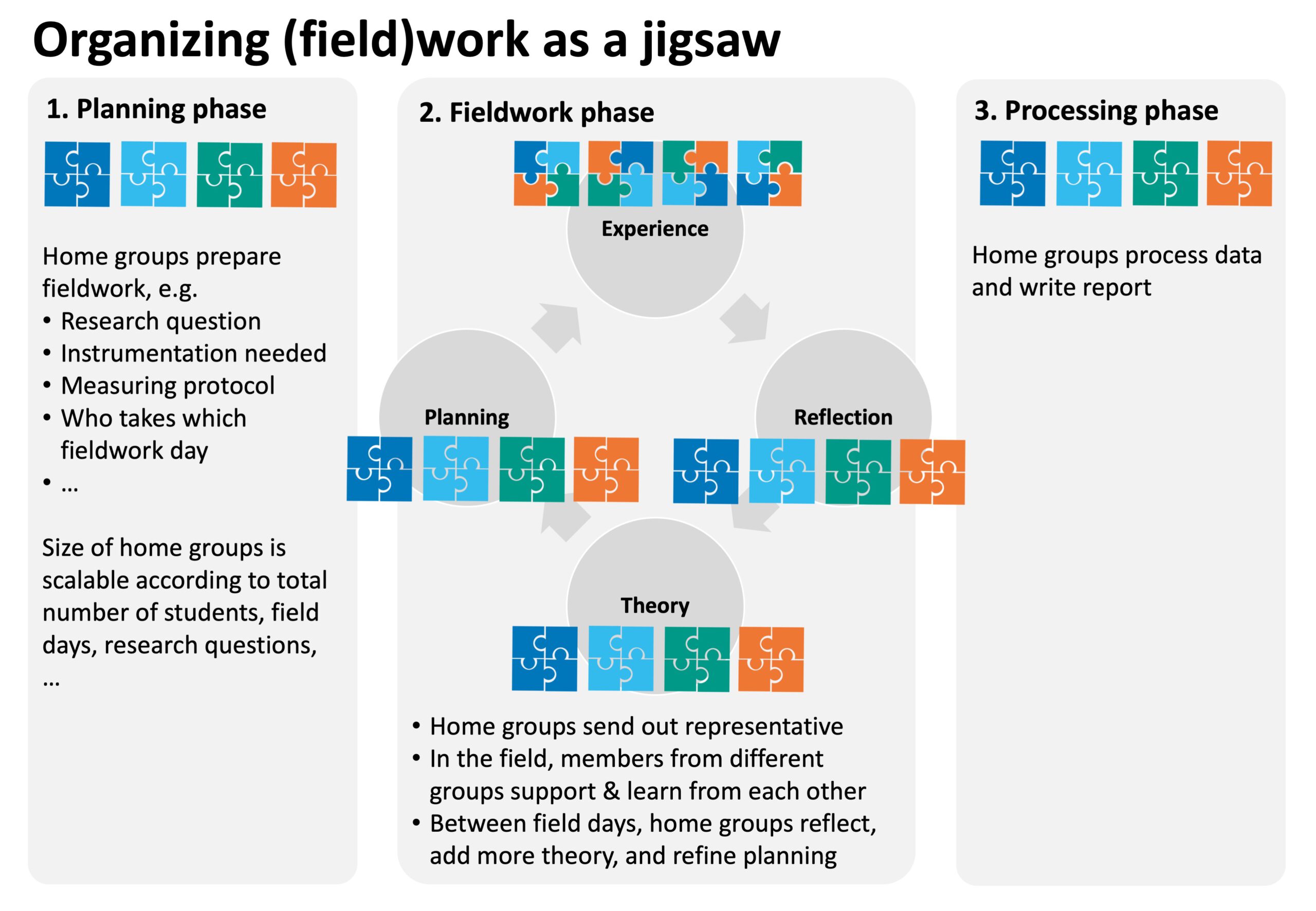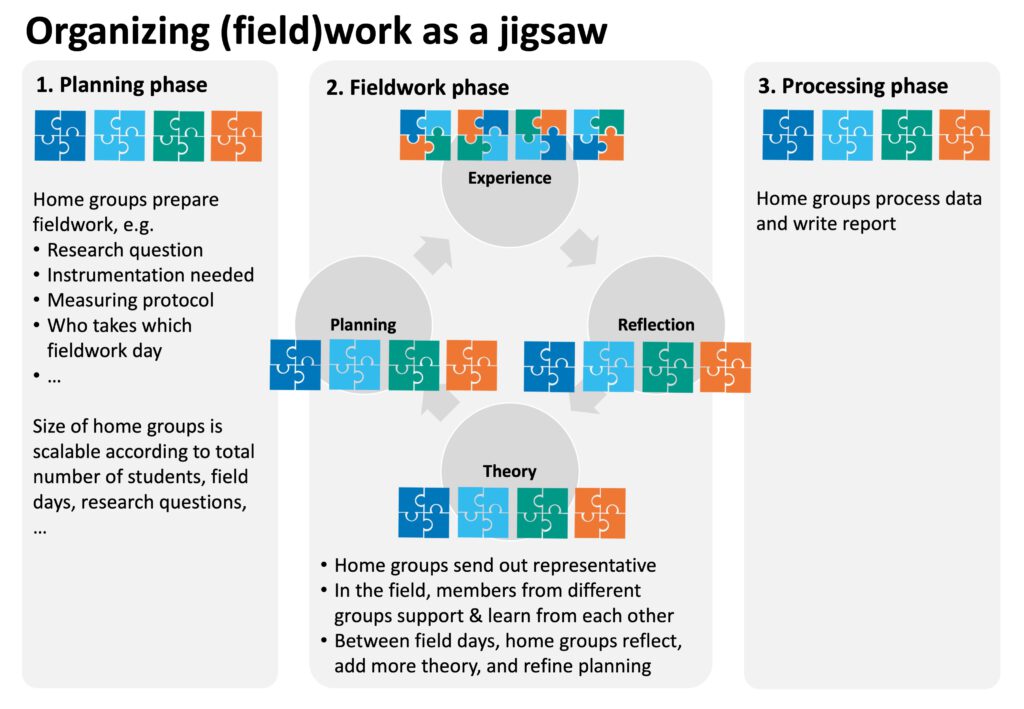
Structuring fieldwork as a jigsaw to increase student responsibility in, and ownership of, their projects
I am a huge fan of Kjersti‘s excellent teaching, it is always so inspiring! She, together with Hans-Christian, developed a jigsaw method to structure preparation for a student cruise, the cruise itself, and then writing of cruise reports. We wrote it up and submitted it for a forthcoming book on field teaching (which I will share links to as soon as they become available), but here comes an extended version for you already!
An important part of studying oceanography is taking part in student cruises: fieldwork on research ships specifically organized to give students the opportunity to participate in authentic research situations and practice practical skills that are quite difficult to obtain outside of the environment where they will be applied. We have previously shared some ideas for how to nudge students to make the most out of fieldwork (using a cool bingo!), but here is another idea that Kjersti and Hans-Christian implemented and that really improved the one-day cruise students typically do very early on in their studies.
Conventionally, and back when I was teaching it (I have to admit), students join the one-day cruise and pretty much work through cookbook-style instructions. There are definitely good reasons behind organizing fieldwork this way: Ship time is very expensive, so we have to make sure the limited time is used efficiently and students get to do everything we want them to experience. But on the downside, students don’t have any autonomy in what they are doing, and thus feel very little ownership. This is sometimes, of course not always, reflected in the engagement students show during the cruise, and in the quality of reports that students submit.
Organizing (field)work as a jigsaw
To get students to be more motivated and engaged, we use a cooperative learning structure: The jigsaw. This gives students individual responsibility for tasks, but also a clear way in which they contribute to the group. Additionally, this gives each individual the support of a whole group of students. We separate the fieldwork into three phases (see figure).

Phase 1: Planning in home groups
In the example in the figure, we have 16 students that we divide into 4 “home” groups à 4 students each (but this is of course scalable to however many students you are working with, how many field days and what kind of instrumentation you have available, and how many different questions you want students to work on, etc.). Staying in this example, we have 4 days on the ship and the home groups work on 4 different research questions (e.g. “how will a floating buoy move relative to the wind?”).
Home groups meet outside of class times to plan the fieldwork. What do they want to measure? How will they do it, do they have the instrumentation they need, do they want to develop/use a protocol, …? Groups of course get support from the teachers and, if needed, from technical staff.
Phase 2a: Fieldwork in mixed groups
On each of the 4 fieldwork days, one student per home group gets to participate, so each group gets 4 attempts to collect data to work with further. During each fieldwork day, each participant is the only representative for their group and has the responsibility to make sure that data for their group is being collected according to the protocol their group agreed upon. But they can draw on the participants from different home groups for help, and are encouraged to learn about each other’s project and to support each other as much as possible. This is an authentic fieldwork experience: You need to collect your own data and are responsible for your own experiments, but you also rely on others for help — and of course help out others as much as possible, too!
Phase 2b: Reflection, theory, and more planning in home groups
In between fieldwork days, the home groups communicate and learn from experiences made at the attempts and, if necessary, make changes to their approach before the next attempt.
Phases 2a and 2b are thus gone through repeatedly, forming an experiential learning cycle with experience during fieldwork, but then reflection, theory, and planning in the home groups in between fieldwork days, and re-entering the experience phase the next fieldwork day.
In contrast to how the experiential learning cycle is usually implemented, the 4 different “experiences” in the field are made by 4 different individuals, and we rely on good communication within the home group for vicarious experiences of the fieldwork days where individuals are not on board the research ship. Since we are close to land and have network coverage, we observe a lot of communication through pictures and texts with the part of the home groups that is left on shore that day.
Phase 3: Processing in the home groups
After the fieldwork, students work in their home groups to analyze the data and write a project report.
So far, so good!
Our experiences with this way of organizing fieldwork are very positive. Students are engaged and free-riding seems greatly reduced. Stress-levels are also lower since students know they have more than one attempt to collect data, and they can collectively learn how to do it (and also have the chance to measure under different conditions so they can discard data from days where the quality was bad because of for example weather conditions).
And last but not least: Students within each home group organize themselves who will show up on which day. So short-notice swaps happen within groups and the teacher doesn’t have to deal with that aspect of logistics (unless someone gets sick for the last day, or other rare cases where students can’t solve logistics on their own).
We have used this cooperative learning structure for student cruises, but it’s easy to imagine using it also for labs or other teaching. How would you use it? What would you change? Let us know! :-)
Added 20.8.2025: The book is out now! This is the reference:
Daae, K., Steen-Larsen, H. C. & Glessmer, M. S., 2025, “Students taking ownership in a jigsaw approach to fieldwork“, in Teaching fieldwork in geography, earth and environmental sciences. France, D., Batty, L. & Swanton, D. (eds.). Edward Elgar Publishing Ltd., p. 261–264
The jigsaw method (with editable files to organise it) - Adventures in Oceanography and Teaching says:
[…] have used the jigsaw method also for cruise preparation (home group), cruise days (expert groups) and report writing (home groups), so over the course of a whole semester rather than “just” one or two course sessions. […]